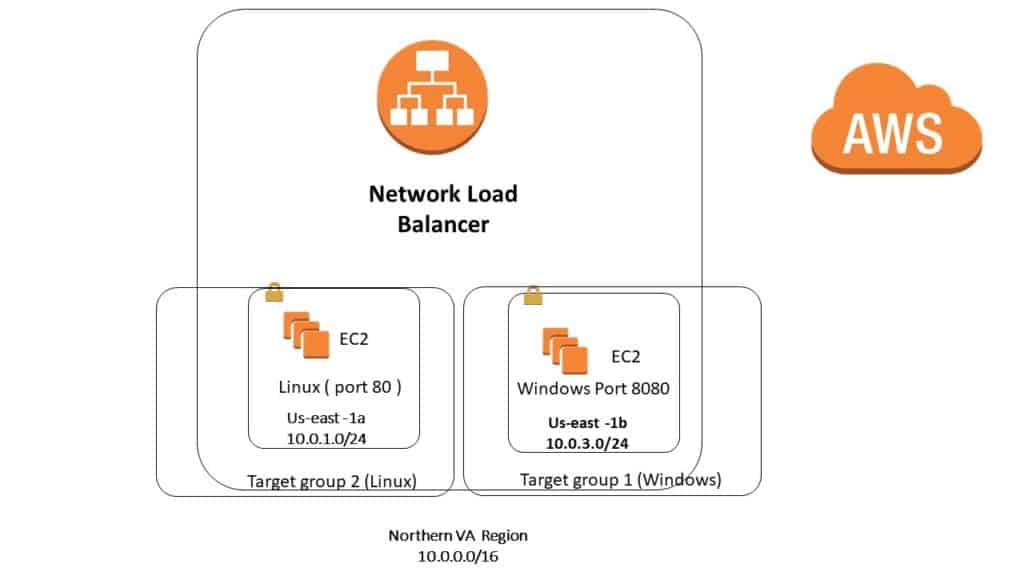
A Network Load Balancer (NLB) is a type of load balancer that operates at the transport layer (layer 4) of the Open Systems Interconnection (OSI) model. It is designed to handle high volumes of traffic, with a focus on low latency and high throughput.
In AWS, a Network Load Balancer distributes incoming traffic across multiple targets, such as EC2 instances, containers, or IP addresses, in multiple Availability Zones. The NLB uses IP hash and TCP load balancing algorithms to determine the best target for each incoming request.
Here’s a simple example of how a Network Load Balancer might work in AWS:
- You have two EC2 instances running in different Availability Zones.
- You create a Network Load Balancer and configure it to balance traffic between these two instances.
- When a client sends a request to the NLB, it uses the IP hash or TCP load balancing algorithm to determine which of the two instances should receive the request.
- The NLB then forwards the request to the selected instance.
- The selected instance processes the request and sends a response back to the client.
In a demo, you could log in to the AWS Management Console and create a Network Load Balancer by following these steps:
- Go to the EC2 service.
- Click on the Load Balancers option.
- Click on the Create Load Balancer button.
- Choose the Network Load Balancer option.
- Fill in the required information, such as the name of the load balancer, the VPC, and the Availability Zones.
- Configure the listeners by specifying the load balancer protocol, port, and target group.
- Create and register targets by choosing the instances or containers that you want the NLB to balance traffic to.
- Review the information and click on the Create button.
Note: This is a simplified example and the exact steps to create a Network Load Balancer in AWS may vary depending on your specific requirements and configuration.
IP Hash is a load balancing algorithm used by Network Load Balancers (NLBs) to distribute incoming traffic across multiple targets. The IP Hash algorithm operates at the transport layer (layer 4) of the Open Systems Interconnection (OSI) model.
The IP Hash algorithm works by taking the client’s IP address and using it to generate a hash value. This hash value is then used to determine the target that should receive the incoming request. The advantage of using the IP Hash algorithm is that it provides a consistent mapping between clients and targets, so subsequent requests from the same client are sent to the same target.
Here’s a simple example of how the IP Hash algorithm works:
- You have two targets, T1 and T2, and a client with IP address C.
- The NLB calculates the hash value for the client’s IP address C.
- The NLB uses the hash value to determine the target to which the incoming request should be sent.
- If the hash value is X, the request is sent to target T1. If the hash value is Y, the request is sent to target T2.
- The selected target processes the request and sends a response back to the client.
In conclusion, the IP Hash algorithm is a simple and effective load balancing algorithm that provides consistent request mapping between clients and targets, making it well-suited for applications that require persistence and stickiness.
How Big Tech Companies use Network Load Balancer ?
- Netflix: Netflix uses Network Load Balancers (NLBs) in its content delivery network (CDN) to balance incoming traffic to its servers. The NLBs handle high volumes of traffic and are critical for ensuring the availability and reliability of the Netflix streaming service.
In order to meet the growing demand for its service, Netflix uses multiple NLBs across multiple regions. The NLBs use the IP Hash algorithm to distribute incoming traffic to the optimal server, based on the client’s IP address. This helps to ensure that requests are distributed evenly and that clients receive a consistent, high-quality streaming experience.
- Dropbox: Dropbox uses Network Load Balancers (NLBs) to balance incoming traffic to its file hosting and collaboration platform. The NLBs are critical for ensuring the availability and reliability of the Dropbox service and handle a high volume of traffic.
In order to meet the growing demand for its service, Dropbox uses multiple NLBs across multiple regions. The NLBs use the IP Hash algorithm to distribute incoming traffic to the optimal server, based on the client’s IP address. This helps to ensure that requests are distributed evenly and that clients receive a consistent, high-quality experience when accessing their files and folders.
In both of these case studies, Network Load Balancers are used to balance incoming traffic to high-traffic, mission-critical services. The IP Hash algorithm provides a consistent mapping between clients and targets, ensuring that requests are distributed evenly and that clients receive a high-quality experience. The use of multiple NLBs across multiple regions provides additional reliability and availability, ensuring that the services remain available even in the event of an outage in a specific region.